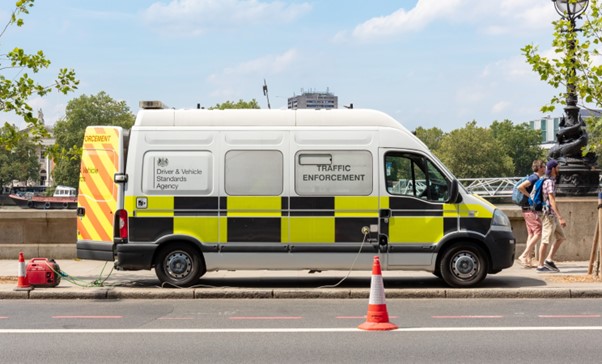
Susie Jones
Проверки DVSA для грузовых автомобилей
Создано: 08.08.2024
•
Обновлено: 08.08.2024
Во время работы водителем грузовика вас могут остановить сотрудники Агентства по стандартам для водителей и транспортных средств (DVSA). Для водителей грузовиков, только начинающих работать в этой отрасли, это может быть пугающим процессом. Однако понимание основных аспектов проверки грузовиков DVSA может сделать этот процесс менее стрессовым.
Кто такая DVSA?
Согласно сайту Gov.uk, DVSA отвечает за "проведение проверок водителей и транспортных средств коммерческих компаний на дорогах, чтобы убедиться, что они соблюдают правила безопасности и обеспечивают безопасность вождения".
DVSA может провести выборочную проверку вашего грузовика и выдать запрет. Запреты не позволяют водителю грузовика управлять автомобилем до тех пор, пока не будет решена проблема с его транспортным средством.
Полиция также имеет право остановить водителя грузовика и провести аналогичную проверку.
Как выглядят экзаменаторы DVSA?
Существует несколько способов опознать инспектора DVSA. Они носят желтые куртки с логотипом DVSA и всегда имеют при себе карточку-ордер. Их автомобили имеют черно-желтый принт с логотипом DVSA на капоте.

Что произойдет, если вас остановят?
Отказ остановиться по требованию экзаменатора DVSA является правонарушением. Если эксперт попросит вас остановиться, он проведет проверку на обочине или на специальном полигоне. Основная цель таких остановок - не допустить появления на дорогах небезопасных автомобилей.
Экзаменатор выполняет следующие обязательные проверки:
Проверка разрешенного веса груза и типа груза
Проверка механических неисправностей и пригодности к эксплуатации на дорогах
Обеспечение правильности записей в тахографе
Убедитесь, что у вас есть действующее водительское удостоверение.
Сколько времени занимает проверка DVSA с выездом на место?
В среднем проверка DVSA занимает 15 минут. Однако в случаях, когда грузовик не соответствует требованиям безопасности, проверка может занять больше времени. Экзаменатор должен выполнить все необходимые проверки независимо от времени.
Как убедиться, что ваш автомобиль пригоден для езды по дорогам
Водитель обязан убедиться в том, что его грузовик пригоден к эксплуатации. Перед каждой поездкой рекомендуется проводить осмотр.
Проверьте следующие элементы:
Свет
Показатели
Топливо и нефть
Шины
Крепления для колес
Кузовной ремонт
Прицепное устройство
Груз и другое оборудование
Проверка автомобиля в кабине (например, ремней безопасности, звукового сигнала, стеклоочистителей, омывателей, рулевого управления и указателя высоты).
Кроме того, водитель грузовика обязан письменно сообщать своей организации о любых дефектах. В них должно быть указано следующее:
Регистрационный или идентификационный знак транспортного средства
Дата проверки
Детали дефектов
Имя лица, сообщившего о дефектах.
Обязанности оператора
Операторы транспортных средств несут ответственность за обеспечение безопасности своих автомобилей и должны выполнять следующие действия:
Оператор должен обеспечить регулярное проведение проверок безопасности всех коммерческих автомобилей
Они должны убедиться, что их водители понимают, какие проверки необходимо проводить.
Запреты на дорогах
Если ваш грузовик не соответствует дорожным требованиям, DVSA может выдать вам два разных запрета - немедленный или отложенный.
Уведомление о немедленном запрете:
Он может вступить в силу немедленно
В большинстве случаев это приведет к обездвиживанию автомобиля
Немедленные запреты могут привести к судебному преследованию.
Отложенное уведомление о запрете:
У оператора есть до 10 дней на решение вопросов
Через десять дней офицеры проведут повторный осмотр автомобиля
Запреты должны быть сняты, прежде чем грузовик сможет ездить.
Запрет на эксплуатацию
Если у грузовика есть механические проблемы или кузов и оборудование не соответствуют стандартам, то на него налагается запрет на эксплуатацию. Для транспортных средств, находящихся за пределами Великобритании, водитель получит немедленный запрет. Для британских операторов тип запрета будет зависеть от степени серьезности дефекта.
Незначительные дефекты:
Незначительные дефекты могут привести к отсроченному запрету
У оператора будет до десяти дней на устранение любых дефектов
Повторная инспекция будет проведена через десять дней.
Серьезные дефекты:
Водитель получит запрет с пометкой "S" за серьезный дефект
Запрет с пометкой "S" накладывается при возникновении проблем с техническим обслуживанием
Если эксперт решит, что непосредственного риска нет, то запреты могут быть отложены
Автомобиль будет обездвижен, а вам грозит судебное преследование.
Запрет с пометкой "S" не будет наложен на следующие действия:
Если во время путешествия возникли проблемы
Проблему обнаружить не удалось (например, дефект нижней части).

Запреты на перегрузку
Если автомобиль перегружен, эксперт DVSA может обездвижить его. В качестве альтернативы эксперт может направить грузовик в близлежащее место, где груз можно перераспределить или снять. Оператор транспортного средства получит уведомление.
Запреты на использование часов водителя
Водители, не соблюдающие правила использования тахографа и часов работы водителя, получат запрет. Это может привести к штрафу, судебному преследованию или обездвиживанию автомобиля.
Подробнее о [Правила и положения о тахографах] (https://https://snapacc.com/newsroom/tachograph-rules-made-easy/)
Хотя экзамены DVSA могут быть пугающей перспективой для водителей грузовиков, они, несомненно, являются положительным фактором в обеспечении безопасности дорожного движения. Убедитесь, что у вас есть правильные проверки и вы следуете основным правилам и нормам, и экзамен DVSA пройдет без проблем.
Как долго вы должны хранить ведомости дефектов грузовиков?
Внедрение системы отчетности о дефектах может стать вашей первой линией защиты при демонстрации того, что ваши автомобили находятся в пригодном для движения состоянии. О работах по устранению дефектов следует сообщать и хранить в течение 15 месяцев. Если дефекты отсутствуют, компания должна вести учет, чтобы убедиться, что водители выполняют свои проверки.
Как часто вам нужно проходить медицинское обследование, чтобы сохранить права?
Чтобы получить и иметь лицензию на управление грузовым автомобилем, необходимо в обязательном порядке пройти медицинский осмотр - без этого вам не выдадут лицензию.
Для водителей моложе 45 лет медицинский осмотр длится до вашего 45-летия. Однако после этого возраста вы должны будете проходить медицинский тест каждые пять лет до 65 лет. Водители 65 лет и старше обязаны проходить медицинское освидетельствование каждый год.



